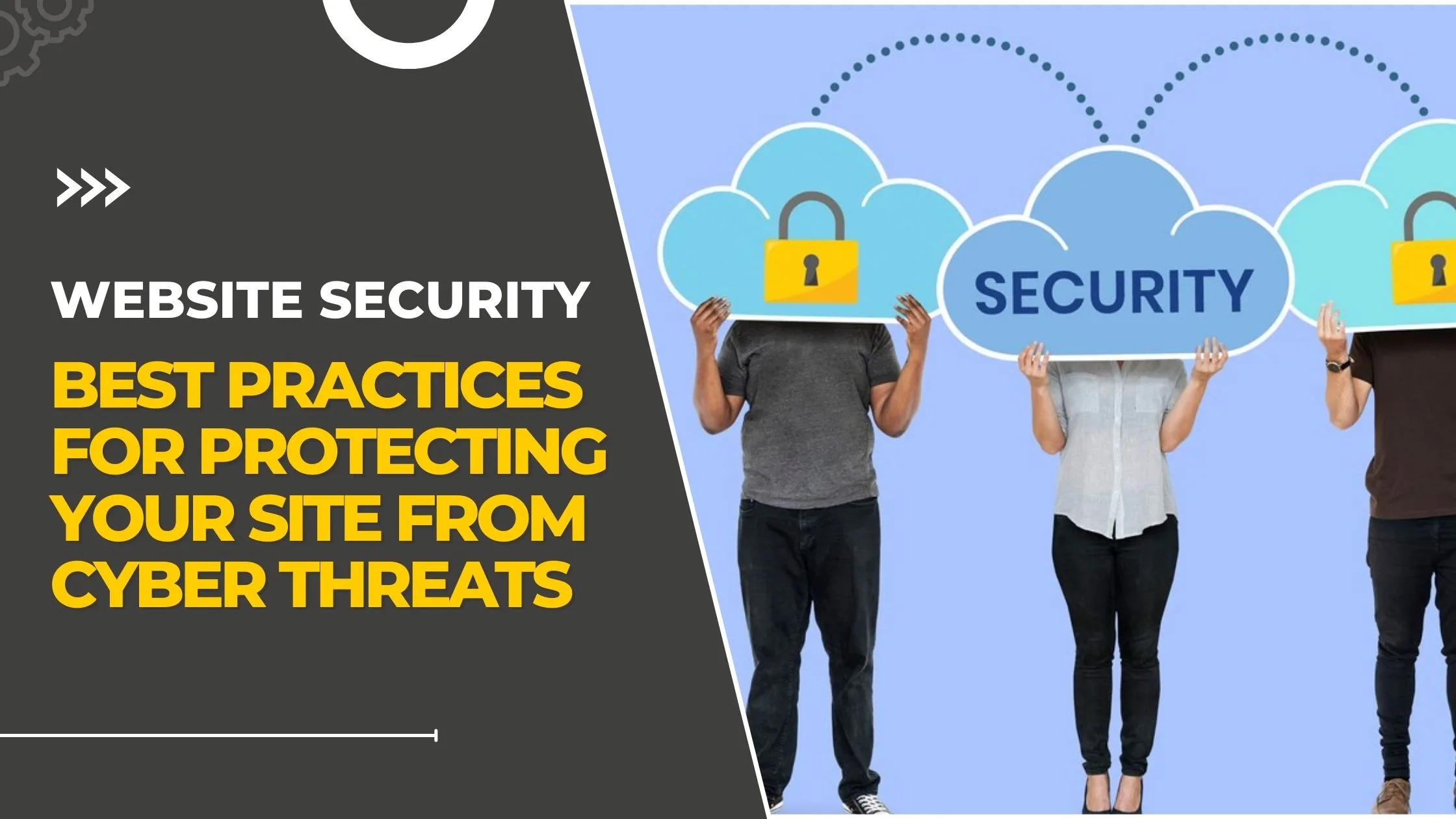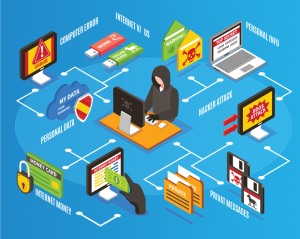Website Security: Best Practices for Protecting Your Site from Cyber Threats
Welcome to the digital age, where websites have become the virtual front doors of businesses around the world. However, with this unparalleled convenience comes a lurking danger – cyber threats. In today’s interconnected world, no website is safe from potential breaches and attacks which can wreak havoc on your online presence.
But fear not! In this blog post, we will unveil a treasure trove of best practices that you can implement to fortify your website’s defenses and safeguard it against any malevolent forces out there. So tighten your seatbelts and get ready to navigate through the maze of website security – because protecting your site has never been more crucial than now!
Introduction to Website Security and Cyber Threats
In today’s digital age, websites have become essential tools for businesses, organizations, and individuals to connect with their audiences. However, with the increased reliance on websites comes an increased risk of cyber threats. Cyber threats are malicious activities that can compromise the security of a website and its users’ sensitive information.
As technology advances, cybercriminals also evolve their tactics and techniques. It is no longer enough to rely on basic security measures; website owners must be proactive in safeguarding their sites against potential attacks. This section will provide an overview of website security and the various cyber threats that it faces so that you can better understand how to protect your site from these risks.
Website security refers to the protection of a website from cyber attacks or unauthorized access to its data or services. A secure website ensures that any information exchanged between the site and its users remains confidential, accurate, and available when needed.
The Importance of Website Security
According to a report by Verizon, 43% of cyber-attacks target small businesses. Many assume that only large companies are at risk; however, this is far from the truth. Hackers often target smaller websites as they have fewer resources dedicated to cybersecurity compared to larger organizations.
The consequences of a cyber attack on a website can be severe. It can lead to financial loss, damage to the site’s reputation, and loss of customer trust. In some cases, a data breach can also result in legal action and fines.
Understanding the Importance of Website Security
Understanding the importance of website security is crucial in today’s digital age, where cyber threats are becoming more sophisticated and prevalent. As a website owner, it is your responsibility to ensure that your site is properly protected from potential breaches or attacks.
Website security refers to the measures and protocols put in place to protect a website from malicious attacks, unauthorized access, and data theft. It encompasses all aspects of web development, including code integrity, server-side security, user authentication, and network security.
Here are some reasons why understanding the importance of website security is essential for any business or individual with an online presence:
1. Protects Sensitive Data: One of the primary reasons for implementing robust website security is to protect sensitive data such as personal information, financial details, and login credentials. Failure to secure this data can lead to identity theft, financial frauds or legal consequences.
2. Maintains User Trust: In today’s digital landscape where customers share personal information on websites regularly, having proper security measures in place can help build trust with your users. They will feel confident that their information is safe and will be more likely to continue using your services.
3. Prevents Malware Infections: Cybercriminals often use malware – malicious software designed to infect systems -to gain access to sensitive data or take control of a website. A well-secured website makes it difficult for hackers to inject malware into the system and prevents any potential damage.
Types of Cyber Threats: Malware, Phishing, DDoS Attacks, etc.
As technology continues to advance, so do the methods used by malicious actors to target websites. With cyber threats becoming increasingly sophisticated and prevalent, it is crucial for website owners to understand the different types of threats in order to effectively protect their sites. In this section, we will discuss some of the most common types of cyber threats – malware, phishing, and DDoS attacks.
1. Malware:
Malware stands for malicious software and refers to any type of software that is designed with malicious intent. This can include viruses, worms, trojans, spyware, adware, and other harmful programs. Malware can be installed on a website through various means such as infected email attachments or compromised plugins/ themes. Once installed on a website, malware can steal sensitive information from users or even take over the site completely. Some examples of malware attacks include ransomware where hackers lock down a site until a ransom is paid and crypto-mining where they use a site’s resources to mine cryptocurrency.
2. Phishing:
Phishing is a type of social engineering attack where cybercriminals trick individuals into sharing sensitive information such as login credentials or financial details through fake emails or websites that imitate legitimate ones. These emails or websites usually create a sense of urgency or fear in order to prompt users into taking immediate action without properly verifying the source or authenticity of the request. Phishing attacks are often used as an entry point for larger-scale attacks like data breaches.
3. DDoS Attacks:
DD oS stands for Distributed Denial of Service and is a type of cyber attack where multiple compromised systems (often infected with malware) are used to flood a website with traffic, causing it to crash or become unavailable. These attacks aim to disrupt the normal functioning of a website and can result in significant financial losses for businesses. DDoS attacks are often carried out by hackers seeking ransom payments or by competitors trying to take down a rival’s website.
Best Practices for Protecting Your Website
In today’s digital age, website security is of utmost importance. With cyber attacks becoming more sophisticated and prevalent, it has become crucial for businesses to prioritize the protection of their website. A single breach can not only compromise sensitive data but also damage a company’s reputation and trust with its customers.
To ensure your website is secure from cyber threats, here are some best practices that you need to implement:
1. Keep Your Software Up-to-Date:
One of the most basic yet effective practices for protecting your website is to regularly update all software used on your site, including content management systems (CMS), plugins, themes, and scripts. These updates often include security patches that address known vulnerabilities in the software.
2. Use Strong Passwords:
Password protection is the first line of defense against hackers. Make sure to use strong passwords that include a combination of uppercase and lowercase letters, numbers, and special characters. It’s also important to change passwords at regular intervals and avoid using the same password for multiple accounts.
3. Implement HTTPS:
HTTPS stands for Hypertext Transfer Protocol Secure, which encrypts communication between a user’s browser and your website server. This added layer of encryption makes it difficult for hackers to intercept sensitive information such as login credentials or financial details.
– Regularly Update Software and Plugins
Keeping your website’s software and plugins up to date is crucial in protecting your site from cyber threats. Outdated software and plugins are often the prime targets for hackers, as they can exploit vulnerabilities to gain access to your website.
Therefore, it is essential to regularly update all software and plugins used on your website. This includes the content management system (CMS) you use, such as WordPress or Drupal, as well as any additional plugins or themes installed.
Here are some best practices for maintaining up-to-date software and plugins:
1. Stay Informed: Keep yourself informed about the latest updates and security patches released by the CMS providers and plugin developers. Sign up for their newsletters or follow them on social media to stay updated on any security issues that may arise.
2. Prioritize Updates: When a new update is released, make sure to prioritize updating critical components such as CMS core files and security-related plugins first before moving onto less important ones.
3. Set Up Automatic Updates: Many CMS platforms have an option to enable automatic updates for core files, themes, and plugins. This can be helpful when you do not have much time to manually go through each update.
4. Use Reliable Sources: Only download themes and plugins from reputable sources such as official marketplaces or developer websites. Avoid downloading free versions of premium themes or plugins from unknown sources, as these may contain malicious code that could compromise your site’s security.
– Implement Strong Passwords and User Authentication Processes
One of the most effective ways to protect your website from cyber threats is to implement strong passwords and user authentication processes. Weak passwords are one of the easiest ways for hackers to gain access to your website, putting all of your sensitive information at risk. By ensuring that all users have a secure password and implementing two-factor authentication, you can greatly reduce the chances of a successful hacking attempt.
Here are some best practices for implementing strong passwords and user authentication processes:
1. Use Complex Passwords: A strong password should be complex, meaning it should include a combination of uppercase and lowercase letters, numbers, and special characters. Avoid using easily guessable information such as pet names or birthdates in your password.
2. Set Minimum Length Requirements: The longer the password, the stronger it is. Make sure to set minimum length requirements so that users cannot create short or weak passwords.
3. Enforce Regular Password Changes: It’s important to regularly change passwords to prevent them from becoming compromised over time. Consider setting a mandatory password change every 90 days for added security.
4. Implement Two-Factor Authentication: This additional layer of security requires users to enter a unique code sent to their mobile device in addition to their password when logging in. This ensures that even if someone has stolen their password, they won’t be able to gain access without physical possession of their phone.
– Use HTTPS Encryption
HTTPS (Hyper Text Transfer Protocol Secure) is an online communication protocol that ensures the secure transfer of data between a website and its users. It utilizes encryption to protect sensitive information, such as passwords, credit card details, and personal information, from being intercepted and accessed by unauthorized parties.
In recent years, HTTPS has become increasingly important for website security due to the rise in cyber threats and attacks. As a website owner, it is crucial to understand the importance of using HTTPS encryption and how it can help protect your site from these threats.
How Does HTTPS Encryption Work?
HTTPS works by encrypting data sent between a user’s browser and a website’s server. This is achieved through Transport Layer Security (TLS) or Secure Sockets Layer (SSL) protocols. These protocols use cryptographic keys to encrypt the data transferred back and forth, making it unreadable for anyone trying to intercept it.
When a user visits a website using HTTPS, their browser will initiate a handshake process with the site’s server. During this process, they exchange cryptographic keys to establish an encrypted connection. Once this connection is established, all data transmitted between the user and the server will be protected.
Top Tools for Website Security
Ensuring the security of your website is crucial in today’s digital landscape. With Cyber threats constantly evolving, it is important to stay ahead and protect your site from potential attacks. Fortunately, there are several tools available that can help enhance your website’s security and minimize the risk of cyber attacks.
1) SSL Certificates: Secure Sockets Layer (SSL) certificates are a must-have for any website. These certificates provide an encrypted connection between your server and the user’s browser, ensuring that sensitive information such as credit card details or login credentials cannot be intercepted by hackers.
2) Web Application Firewall (WAF): A WAF acts as a protective shield against malicious traffic by filtering out potentially harmful requests before they reach your web application. It monitors all incoming traffic and blocks suspicious activity, keeping your site safe from common vulnerabilities like SQL injections and cross-site scripting attacks.
3) Two-Factor Authentication (2FA): 2FA adds an extra layer of security to your website by requiring users to provide two forms of identification before accessing their account. This could include a password and a unique code sent to their phone or email. It reduces the risk of unauthorized access even if a hacker manages to obtain login credentials.
4) Anti-malware/ Antivirus Software: Keeping your server clean from malware is essential for maintaining website security. Investing in reliable anti-malware/ antivirus software will detect any malicious files on your server and remove them before they cause harm.
Conclusion
In today’s digital age, website security is more important than ever. With cyber threats constantly evolving, it is crucial for website owners to implement best practices in order to protect their site and its visitors from potential attacks.
In this blog article, we discussed the various ways in which you can strengthen your website security. By following these best practices, you can significantly reduce the risk of your site being compromised by cyber threats.





